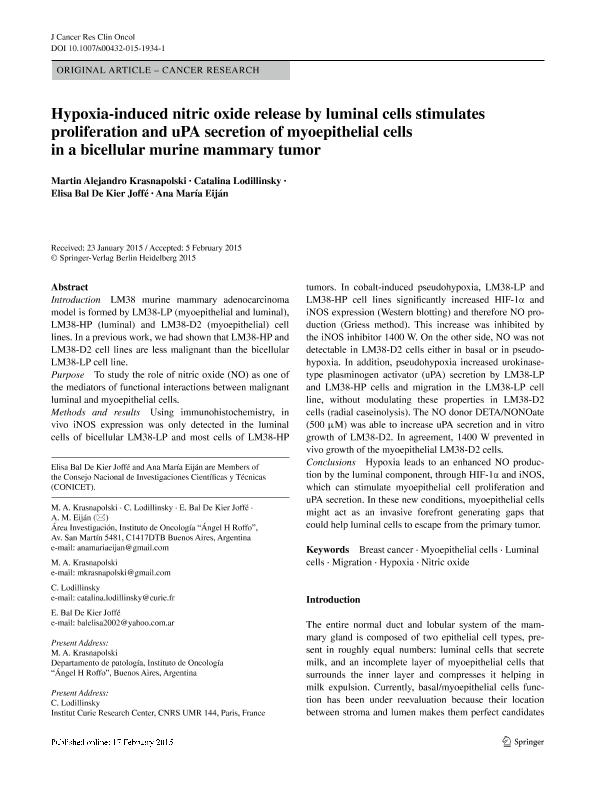Artículo
Hypoxia-induced nitric oxide release by luminal cells stimulates proliferation and uPA secretion of myoepithelial cells in a bicellular murine mammary tumor
Fecha de publicación:
10/2015
Editorial:
Springer Heidelberg
Revista:
Journal Of Cancer Research And Clinical Oncology
ISSN:
0171-5216
e-ISSN:
1432-1335
Idioma:
Inglés
Tipo de recurso:
Artículo publicado
Clasificación temática:
Resumen
Introduction: LM38 murine mammary adenocarcinoma model is formed by LM38-LP (myoepithelial and luminal), LM38-HP (luminal) and LM38-D2 (myoepithelial) cell lines. In a previous work, we had shown that LM38-HP and LM38-D2 cell lines are less malignant than the bicellular LM38-LP cell line.
Purpose: To study the role of nitric oxide (NO) as one of the mediators of functional interactions between malignant luminal and myoepithelial cells.
Methods and results: Using immunohistochemistry, in vivo iNOS expression was only detected in the luminal cells of bicellular LM38-LP and most cells of LM38-HP tumors. In cobalt-induced pseudohypoxia, LM38-LP and LM38-HP cell lines significantly increased HIF-1α and iNOS expression (Western blotting) and therefore NO production (Griess method). This increase was inhibited by the iNOS inhibitor 1400 W. On the other side, NO was not detectable in LM38-D2 cells either in basal or in pseudohypoxia. In addition, pseudohypoxia increased urokinase-type plasminogen activator (uPA) secretion by LM38-LP and LM38-HP cells and migration in the LM38-LP cell line, without modulating these properties in LM38-D2 cells (radial caseinolysis). The NO donor DETA/NONOate (500 μM) was able to increase uPA secretion and in vitro growth of LM38-D2. In agreement, 1400 W prevented in vivo growth of the myoepithelial LM38-D2 cells.
Conclusions: Hypoxia leads to an enhanced NO production by the luminal component, through HIF-1α and iNOS, which can stimulate myoepithelial cell proliferation and uPA secretion. In these new conditions, myoepithelial cells might act as an invasive forefront generating gaps that could help luminal cells to escape from the primary tumor.
Palabras clave:
Breast Cancer
,
Myoepithelial Cells
,
Hypoxia
,
Nitric Oxide
,
Luminal Cells
,
Migration
Archivos asociados
Licencia
Identificadores
Colecciones
Articulos(OCA HOUSSAY)
Articulos de OFICINA DE COORDINACION ADMINISTRATIVA HOUSSAY
Articulos de OFICINA DE COORDINACION ADMINISTRATIVA HOUSSAY
Citación
Krasnapolski, Martin Alejandro; Lodillinsky, Catalina; Bal, Elisa Dora; Eijan, Ana Maria; Hypoxia-induced nitric oxide release by luminal cells stimulates proliferation and uPA secretion of myoepithelial cells in a bicellular murine mammary tumor; Springer Heidelberg; Journal Of Cancer Research And Clinical Oncology; 141; 10; 10-2015; 1727-1738
Compartir
Altmétricas




